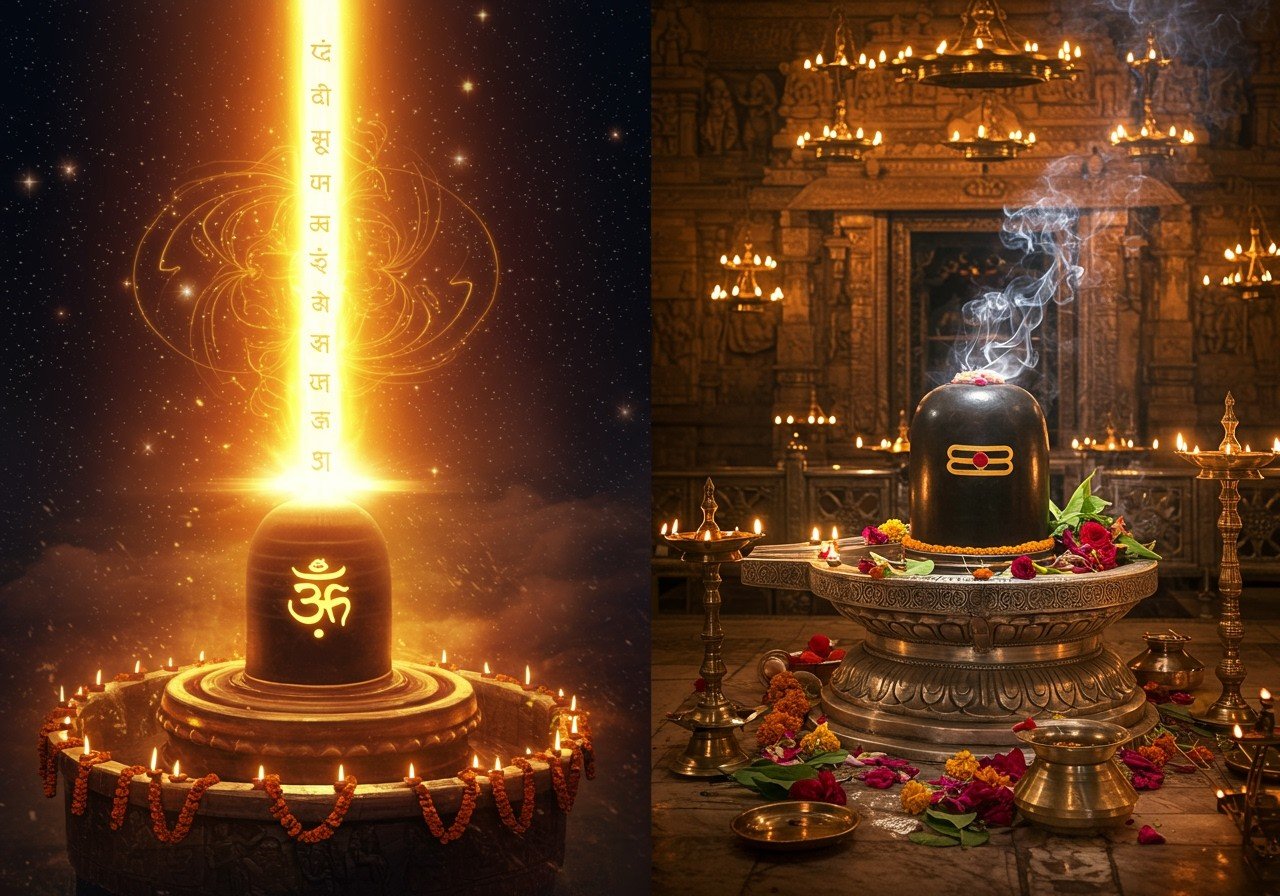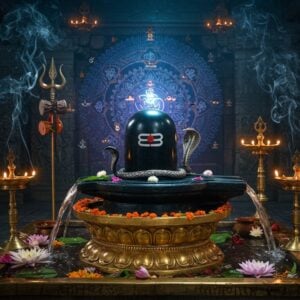
The Jyotirlinga and Shivling are deeply revered symbols in Hinduism, each holding profound spiritual significance. Understanding the essence of these sacred emblems enriches our spiritual journey and deepens our appreciation for the rich tapestry of our traditions. Let’s explore their origins, the key differences between them, and how these traditions continue to thrive in modern times.
Understanding the Jyotirlinga
Jyotirlinga: The Radiant Sign of the Almighty
A Jyotirlinga is not merely a symbol; it is believed to be a manifestation of Lord Shiva himself, radiating divine light and energy. The term “Jyotirlinga” literally translates to “lingam of light,” representing the infinite and eternal nature of Lord Shiva. Ancient scriptures, like the Shiva Purana, speak of twelve Jyotirlingas spread across the sacred land of India, each with its own unique legend and spiritual resonance. These include renowned sites like the Somnath Jyotirlinga in Gujarat and Kashi Vishwanath in Varanasi. You can read more about the Somnath Temple and its significance here and find a complete guide to pilgrimage here.
Undertaking a pilgrimage to a Jyotirlinga is considered a deeply spiritual act for devotees. These sites are not just places of worship; they are architectural marvels, attracting both the devout and those seeking to experience the rich cultural heritage of India. They are vital to the local communities, fostering a sense of togetherness through religious tourism and traditional rituals.
Grasping the spiritual weight and historical significance of the Jyotirlingas deepens our reverence for these holy places and strengthens our connection with the divine.
Understanding the Shivling
Shivling: A Symbol of Shiva’s Divine Energy
The Shivling is a symbolic representation of Lord Shiva, embodying his divine energy and potential. The word “linga” in Sanskrit means “mark” or “symbol,” signifying the presence of the divine. The Shivling is often seen as a representation of the union of male and female energies – Prakriti (nature) and Purusha (consciousness) – a balance that is fundamental to Hindu philosophy.
Shivlings are found in abundance across India, crafted from various materials like stone, metal, or even naturally occurring formations. They are integral to both temple worship and personal shrines in homes, playing a central role in daily prayers and rituals. Devotees traditionally offer milk, water, and flowers to the Shivling, symbolizing purity, reverence, and devotion.
Beyond its symbolic representation of Lord Shiva, the Shivling is also associated with the cosmic pillar of creation. It represents the cyclical nature of the universe – creation, preservation, and transformation – a concept central to Hindu cosmology.
Key Differences between Jyotirlinga and Shivling
While both the Jyotirlinga and the Shivling honor Lord Shiva, they have distinct roles and significance within Hindu worship.
- Jyotirlinga: A Jyotirlinga is believed to be a self-manifested “pillar of light,” a direct manifestation of Lord Shiva in radiant form. There are traditionally twelve Jyotirlingas in India, each steeped in unique legends and spiritual power.
- Shivling: Shivlings are more commonly found and serve as tangible symbols of Lord Shiva for worship. While all Jyotirlingas are Shivlings, not all Shivlings are Jyotirlingas. The twelve Jyotirlingas hold a special place of reverence in pilgrimage and spiritual narratives.
The temples housing the Jyotirlingas are often grand and architecturally intricate, reflecting their sacred status and attracting pilgrims from all corners of India seeking spiritual enlightenment and blessings. Shivling temples, while varying in size and architectural style, remain integral to the religious life of local communities.
Cultural and Spiritual Significance
Both the Jyotirlinga and the Shivling are deeply interwoven with Hindu culture and spirituality, inspiring artistic expression in various forms, including music, literature, and sculpture. These symbols serve as a unifying force, strengthening community bonds through shared traditions and festivals like Mahashivratri.
Worshipping these sacred symbols provides solace, guidance, and a sense of connection with the divine, reminding us of the spiritual presence within and around us. This connection cultivates inner peace, understanding, and a deeper appreciation for the interconnectedness of life.
In our modern times, there are ways to make these traditions more accessible. Online puja services and virtual pilgrimages offer a way to experience the sacred, even from the comfort of our homes. These adaptations bridge the gap between tradition and convenience, ensuring our rich cultural heritage remains vibrant and accessible to all.
Shop Authentic Puja Items at Poojn.in
At Poojn.in, we offer a diverse selection of authentic puja items to enhance your spiritual practice. Our pure marble dust Shivlings, ideal for both worship and home décor, are crafted with utmost care and reverence. We also offer a variety of sizes and designs to choose from, allowing you to select the perfect Shivling for your needs.
Explore our exquisite collection of Shivlings:
Adiyogi Marble Dust Murti
Lord Shiva Marble Dust Murti (5-inch)
Standing Shiva Pure Marble Dust Murti (9-inch)
Ganga Shiva Pure Marble Dust Murti (13-inch)
To complement your puja rituals, we also offer a wide range of essential items:
- Pure camphor tablets for aarti
- Elegantly designed puja thalis and accessories
- Sacred Gangajal for abhishek
- Traditional bell-metal items
- Authentic rudraksha malas
Visit us online at www.poojn.in, call us at 03369029784, or WhatsApp us at 9476142738 for assistance or to place your order. We offer special pricing for wholesale customers and guarantee secure delivery throughout India. All our products undergo stringent quality checks and are packaged with care to preserve their sanctity.
Note: Prices are subject to change. Please visit our website for current pricing and availability.
Embracing Tradition, Embracing the Divine
By understanding the nuances between the Jyotirlinga and the Shivling, we gain a deeper appreciation of their unique roles in Hindu spirituality. Both symbols offer a pathway to connect with Lord Shiva, fostering inner peace and spiritual understanding. They serve as reminders of the delicate balance and cyclical nature of life, weaving the threads of tradition into our daily lives. Whether you journey to a majestic Jyotirlinga temple or offer your prayers to a Shivling at home, the divine presence of Lord Shiva is always with you.
Frequently Asked Questions about Jyotirlinga and Shivling
What sets a Jyotirlinga apart from a Shivling?
A Jyotirlinga is a specific sacred place where Lord Shiva is believed to have appeared as a radiant pillar of light, while a Shivling serves as a symbolic representation of Lord Shiva, worshipped in temples and homes.
How many Jyotirlingas are there?
Tradition holds that there are twelve Jyotirlingas scattered across India, each considered highly sacred by devotees of Lord Shiva.
Can I find a Shivling at a Jyotirlinga site?
Yes, you’ll find a Shivling at every Jyotirlinga site. It is the focal point for worship and rituals.
Why are Jyotirlingas considered especially sacred?
The belief that Lord Shiva himself manifested at these sites as a pillar of light gives Jyotirlingas a unique spiritual significance.
Do Jyotirlingas and Shivlings look the same?
While both represent Lord Shiva, Jyotirlingas are linked to particular temples and can have distinct architectural features. Shivlings vary in size and form, often crafted from materials like stone or metal.
Is visiting a Jyotirlinga more spiritually rewarding than worshipping a Shivling at home?
Many believe that a pilgrimage to a Jyotirlinga carries special blessings due to its divine origin. However, worshipping a Shivling at home with sincere devotion is also deeply fulfilling.
Are there specific rituals for Jyotirlingas?
Jyotirlinga rituals often involve unique prayers and offerings specific to each location. Shivling worship generally follows a common pattern, but Jyotirlinga rituals can be more elaborate.
Can I worship a Shivling at home?
Absolutely. Worshipping a Shivling at home is a widespread practice, allowing for a personal connection with Lord Shiva, similar to the experience of visiting a Jyotirlinga.


